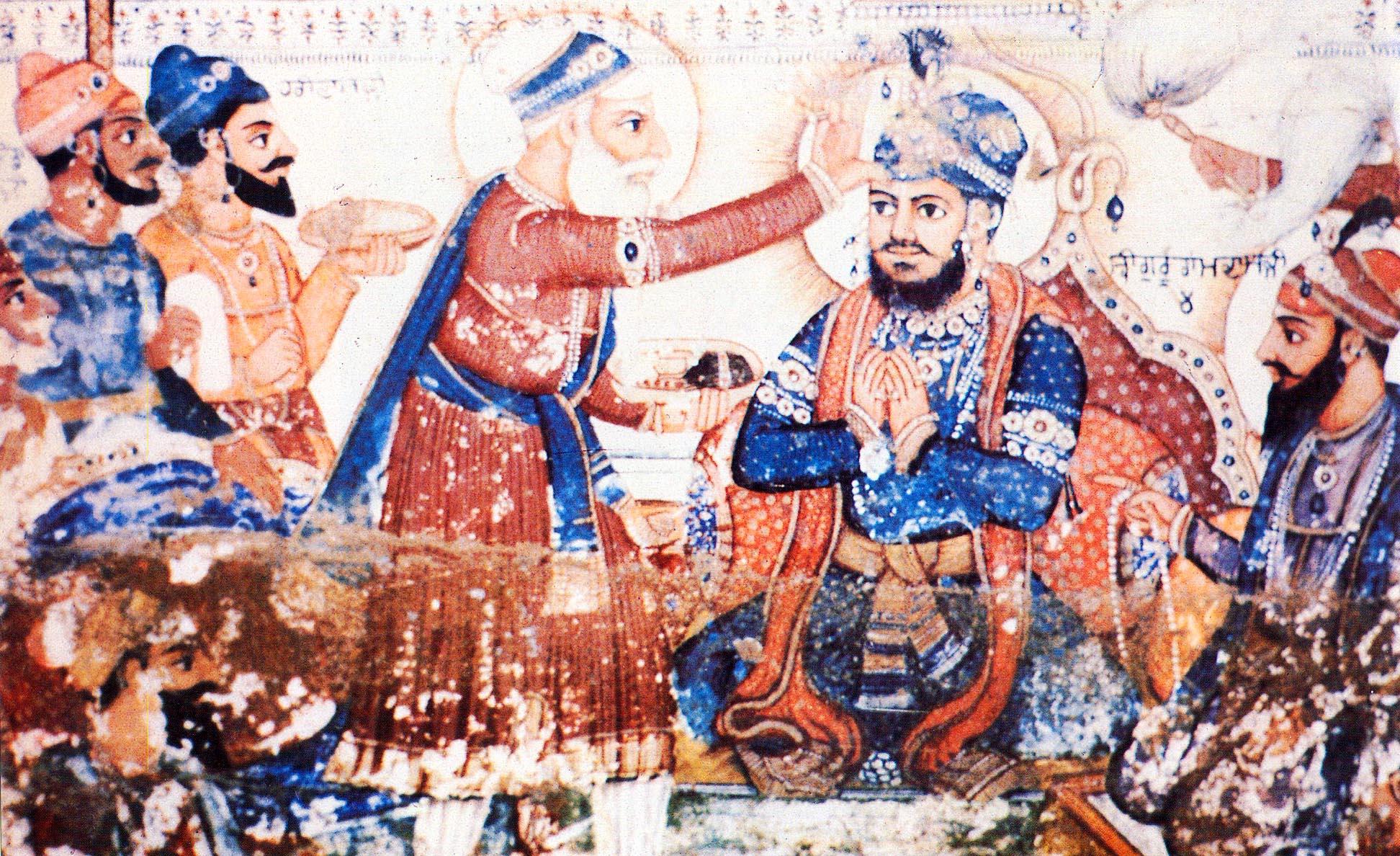Rituals in Sikhism: wedding, festivals, funeral:
Guru Amar Das composed the rapturous hymn called Anand and made it a part of the ritual of Sikh marriage called "Anand Karaj", which literally means "blissful event".
The Anand hymn is sung, in contemporary times, not only during Sikh weddings but also at major celebrations. Parts of the "Anand hymn" are recited in Sikh temples (Gurdwara) every evening, at the naming of a Sikh baby, as well as during a Sikh funeral.[19] It is a section of the Anand Sahib composition of Guru Amar Das, printed on pages 917 to 922 of the Adi Granth and set to the "Ramkali" raga.[19][20]
Guru Amar Das's entire Anand Sahib composition is a linguistic mix of Panjabi and Hindi languages, reflecting Guru Amar Das' upbringing and background. The hymn celebrates the freedom from suffering and anxiety, the union of the soul with the divine, describing a devotee's bliss achieved through the Guru with inner devotion and by repeating the Name of the Creator.[20] The hymn states in stanza 19 that the Vedas teach "the Name is supreme", in stanza 27 that Smriti and Shastra discuss the good and the bad but are unreal because they lack a Guru and that it is the grace of the Guru which awakens the heart and the devotion to the Name. The hymn celebrates the life of a householder and constant inner devotion to the One, ending each stanza with the characteristic "says Nanak".
Guru Amar Das is also credited in the Sikh tradition to have encouraged building of temples and places where Sikhs could gather together on festivals such as Maghi,[23] Diwali and Vaisakhi.[24][25] He required his disciples to gather together for prayers and communal celebrations in autumn for Diwali and in spring for Vaisakhi, both post harvest ancient festivals of India.
Guru Amar Das composed the rapturous hymn called Anand and made it a part of the ritual of Sikh marriage called "Anand Karaj", which literally means "blissful event".
The Anand hymn is sung, in contemporary times, not only during Sikh weddings but also at major celebrations. Parts of the "Anand hymn" are recited in Sikh temples (Gurdwara) every evening, at the naming of a Sikh baby, as well as during a Sikh funeral.[19] It is a section of the Anand Sahib composition of Guru Amar Das, printed on pages 917 to 922 of the Adi Granth and set to the "Ramkali" raga.[19][20]
Guru Amar Das's entire Anand Sahib composition is a linguistic mix of Panjabi and Hindi languages, reflecting Guru Amar Das' upbringing and background. The hymn celebrates the freedom from suffering and anxiety, the union of the soul with the divine, describing a devotee's bliss achieved through the Guru with inner devotion and by repeating the Name of the Creator.[20] The hymn states in stanza 19 that the Vedas teach "the Name is supreme", in stanza 27 that Smriti and Shastra discuss the good and the bad but are unreal because they lack a Guru and that it is the grace of the Guru which awakens the heart and the devotion to the Name. The hymn celebrates the life of a householder and constant inner devotion to the One, ending each stanza with the characteristic "says Nanak".
Guru Amar Das is also credited in the Sikh tradition to have encouraged building of temples and places where Sikhs could gather together on festivals such as Maghi,[23] Diwali and Vaisakhi.[24][25] He required his disciples to gather together for prayers and communal celebrations in autumn for Diwali and in spring for Vaisakhi, both post harvest ancient festivals of India.
Rituals in Sikhism: wedding, festivals, funeral:
Guru Amar Das composed the rapturous hymn called Anand and made it a part of the ritual of Sikh marriage called "Anand Karaj", which literally means "blissful event".
The Anand hymn is sung, in contemporary times, not only during Sikh weddings but also at major celebrations. Parts of the "Anand hymn" are recited in Sikh temples (Gurdwara) every evening, at the naming of a Sikh baby, as well as during a Sikh funeral.[19] It is a section of the Anand Sahib composition of Guru Amar Das, printed on pages 917 to 922 of the Adi Granth and set to the "Ramkali" raga.[19][20]
Guru Amar Das's entire Anand Sahib composition is a linguistic mix of Panjabi and Hindi languages, reflecting Guru Amar Das' upbringing and background. The hymn celebrates the freedom from suffering and anxiety, the union of the soul with the divine, describing a devotee's bliss achieved through the Guru with inner devotion and by repeating the Name of the Creator.[20] The hymn states in stanza 19 that the Vedas teach "the Name is supreme", in stanza 27 that Smriti and Shastra discuss the good and the bad but are unreal because they lack a Guru and that it is the grace of the Guru which awakens the heart and the devotion to the Name. The hymn celebrates the life of a householder and constant inner devotion to the One, ending each stanza with the characteristic "says Nanak".
Guru Amar Das is also credited in the Sikh tradition to have encouraged building of temples and places where Sikhs could gather together on festivals such as Maghi,[23] Diwali and Vaisakhi.[24][25] He required his disciples to gather together for prayers and communal celebrations in autumn for Diwali and in spring for Vaisakhi, both post harvest ancient festivals of India.
0 Comments
0 Shares
0 Reviews




